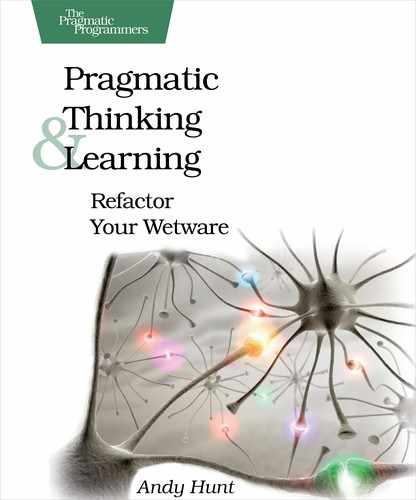Take It to the Streets
So far, we’ve seen the Dreyfus model and seen what it means to be an expert. I’ve shown you some of the myriad wonders of the brain, including an entire half that’s probably underutilized.
In this chapter, we’ve taken a good look at what learning is—and what it is not. We’ve looked at using SMART objectives and a Pragmatic Investment Plan and some specific techniques including reading techniques, mind maps, and learning by teaching.
But all this learning is only part of the equation; next we need to look at putting learning into action and see the best ways to gain experience. We’ll play with that in the next chapter.
In the meanwhile, it’s time to begin to take it to the streets—to leave the relatively safe cloisters of the cubicle and begin to interact with the world to advance your personal learning.
| Next Actions |
-
Take a new topic, and try to teach it to a co-worker or relative. What did you learn from teaching—and the preparation for teaching?
-
If you haven’t been going to a local user group, start going. Java, Ruby, and Linux groups are plentiful, but you might also find groups devoted to Delphi, agile or XP development, OOP, specific vendor products, and more.
-
Listen carefully to the speakers. Make a mind map of the topic area. What would you add to it? What would you do differently? Write up a critique for the group based on your mind map.
-
Contact the organizers, and offer to speak on your topic for an upcoming meeting.
-
If that’s not comfortable for you, then write an article on your topic or blog on it.
Footnotes
| [97] |
Cited in Influence: Science and Practice [Cia01]. |
| [98] |
Klemp, G. O. “Three Factors of Success” in Knowledge and Competence: Current Issues in Education and Training [BW90]. |
| [99] |
Originated in The Practice of Management [Dru54] and widely used since then. |
| [100] |
Meditation XVII, 1623 A.D. |
| [101] |
Thanks to Paul Oakes for suggesting this. |
| [102] |
Thanks to Bobby G. Bodenhamer, at http://www.neurosemantics.com, for permission to reproduce this table. |
| [103] |
Frames of Mind: The Theory of Multiple Intelligences [Gar93]. |
| [104] | |
| [105] |
For even more on this subject, see Knowledge Hydrant: a Pattern Language for Study Groups [Ker99]. |
| [106] |
Described in Effective Study [Rob70]. |
| [107] |
Crossing senses, imagining that numbers have colors, words smell a certain way, and so on. |
| [108] |
The Critical Importance of Retrieval for Learning [KR08]. Thanks to June Kim for spotting this one. |
| [109] |
Possibly beginning with the Greek philosopher Porphyry of Tyros, according to Wikipedia. Of course, cave drawings go back even further, if you don’t mind bison in your mind map. |
| [110] |
Thanks to Bert Bates for reminding me about this. |
| [111] |
I use NovaMind, for Mac/Windows, at http://www.novamind.com. |
| [112] |
See Affinity Grouping in Behind Closed Doors: Secrets of Great Management [RD05] for more information on this and other fun things to do with sticky notes. |
| [113] |
Many cell phones and laptops (and most Macs) now come with built-in cameras, so capturing just keeps getting easier. |
| [114] |
